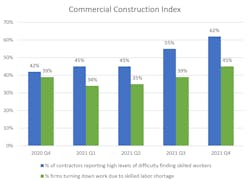To stay competitive and reduce operational costs inherent with legacy technologies, MSOs have a unique opportunity to utilize incoming federal and state broadband funding to upgrade their plant to an all-fiber network. With homes passed affecting service provider valuation on Wall Street, rapid service turnup has become a necessity. Increased market demand for gigabit-class services is driving greenfield deployments, competitive overbuild, and replacement of legacy copper and coax with future-proof networks.
At the same time, given that skilled fiber technician shortages persist, carriers have looked towards ways of overcoming deployment challenges by taking advantage of new techniques and craft-friendly technology. Using products tailored to simplify installation by reducing complexity can significantly cut current installation times. These advances include, for example, improved fiber cabinet designs that eliminate the splice case, allowing technicians to splice once on-site instead of twice. By taking advantage of more efficient technologies, carriers have been able to cut fiber installation times up to half, bringing associated revenues in parallel.
No Quick Solutions for Fiber Technician Shortages
As highlighted in the figure below, a U.S. Chamber of Commerce report showed that contractors said the already chronic problem of finding enough skilled workers turned worse at the end of last year.1 The vast majority (91%) of contractors reported moderate to high levels of difficulty finding skilled workers, up three points from Q2. But more telling is the fact that 62% of contractors reported high levels of difficulty finding skilled workers, rising seven points from the previous quarter. This is 20 points higher from just a year previously when 42% of contractors reported high difficulty in finding these workers.
One of the biggest problems facing the broadband industry is ensuring there are enough workers available to construct and install sufficient network capacity to meet demand. This goal requires qualified skilled laborers across the entire ecosystem—manufacturing, installation, maintenance services, and software development.2 Just take a look at what is required for installers. Network build projects are kicking off and will be well funded for the next several years. These networks will be built to scale up as network demands increase but they require technicians who know what they are doing. These installers are in high demand across the country.
In a March 2021 policy brief from the Brookings Institution on federal infrastructure investment, researchers estimated that a federal investment of $80 billion to deploy high-speed broadband infrastructure would directly create an approximate 200,000 job-years.3 Jobs would be spread across approximately 130 occupations nationwide, primarily in installation, maintenance, and repair. Imagining these jobs were created at once, there would not be enough skilled unemployed or underemployed workers in the broadband sector to meet the demand.
If we were to look at the needs over the next five years, Deborah Kish, vice president of research and workforce development at the Fiber Broadband Association (FBA), estimates up to 25,000 new jobs will need to be created to meet service provider demands for fiber installation and maintenance personnel. The FBA and other organizations are ramping up efforts to train and certify more technicians to fill current and future needs. Most recently the association launched its OpTIC™ technician training course that will be taught in partnership with local community colleges. While these programs expect to deliver in the long term, they will take time to reach momentum and reduce existing workforce shortages.
With skilled fiber technicians expected to be in continued short supply in the near term, it is incumbent on operators to maximize the effectiveness of their existing workforce. To do so, operators are leveraging a combination of thoughtful planning prior to network deployment to reduce and remove potential technician frictions before the first fiber is pulled and incorporating the use of craft-friendly technologies to simplify and accelerate fiber deployments and repairs.
Doubling the Rate of Fiber Homes Passed is a Matter of Time
Surpassing your deployment milestones by doubling the rate of your PON cabinet deployments is possible. For example, many service providers now use modular building-block architectures with patch and splice cassettes. This approach requires no splice case, no vault, and no special inventory management. Splicing inside the fiber cassette will cut in half the time to place a cabinet, minimize labor costs, and reduce operations maintenance costs.
How is this possible? Let’s dive in. Fiber distribution hub (FDH) cabinets come in many different styles, shapes, and sizes. Most popular sizes range from 144- to 432-count FDH cabinets. A common legacy method of FDH cabinet deployment ships with a high-count fiber tail from the factory that gets spliced into the feeder (F1) and distribution (F2) fibers in the field within a splice case at a vault near the cabinet. This operation requires opening the vault, pumping the manhole, setting up safety cones and signs that affect traffic, prepping multiple F1 and F2 cables, opening the splice case, tray preparation, bringing the fiber tails to the splice point, splicing the fibers, closing the splice case, and properly securing the F1 and F2 cables. Depending on the size of the cabinet and whether it is an aerial or pole-mounted cabinet, the total installation time takes between six to nine hours.
As just mentioned, many vendors support this type of installation using a cabinet with a fiber tail spliced in at the factory. This is sold as a good thing because it is “factory-spliced” instead of “field-spliced.” The inference is that factory versus the field means higher quality.
Alternatively, to stay competitive and reduce operational costs inherent with legacy technologies, service providers are turning to patch-and-splice deployments using in-cassette splicing as they upgrade their outside plant to an all-fiber network.
With in-cassette splicing, the FDH cabinets ship from the factory without fiber tails but equipped with cassettes ready for splicing in the field. This type of FDH cabinet is safer for the technicians as there are no traffic concerns and no need to set up cones diverting the street traffic. The F1 and F2 fibers terminate directly in the cassette. Many installation sites start with a cabinet that is 50% loaded with cassettes. The beauty of this setup is that providers can align their capital costs with subscriber take rates. This operation requires prepping only as many F1 and F2 cables as there are cassette ports, prepping the cassette, bringing the cassette to the fiber tails for splicing, splicing the fibers in the cassette, putting the cassettes back in the cabinet, and properly securing the F1 and F2 cables. Depending on the size of the cabinet and whether it is an aerial or pole-mounted cabinet, the total installation time takes between two to five hours. That’s a 50% savings in installation time and that time is money.
Fiber Deployments Must Evolve out of Necessity
The famous proverb states that necessity is the mother of invention. The challenge is to deploy fiber faster.
With homes passed affecting service provider success, rapid service turnup has become a necessity. Increased market demand for gigabit-class services is driving greenfield deployments, competitive overbuild, and replacement of legacy copper and coax with future-proof networks. At the same time, given that skilled fiber technician shortages continue to persist, carriers look for ways to overcome deployment challenges by taking advantage of new techniques and craft-friendly technology.
Using products tailored to simplify installation by reducing complexity can significantly cut installation times. Improved fiber cabinet designs eliminate the need for a splice case and the additional installation time. By taking advantage of more efficient technologies, service providers can cut fiber cabinet installation times in half—speeding time to revenue.
References
- https://www.uschamber.com/assets/documents/Q4-2021-CCI-Report.pdf.
- https://www.commerce.gov/sites/default/files/2022-02/Assessment-Critical-Supply-Chains-Supporting-US-ICT-Industry.pdf.
- Marcela Escobari, Dhruv Gandhi, and Sebastian Strauss, “How federal infrastructure investment can put America to work,” The Brookings Institution, March 2021, https://www.brookings.edu/wp-content/uploads/2021/03/Federal-infrastructure-investment.pdf.
Kevin Morgan is chief marketing officer of Clearfield.






